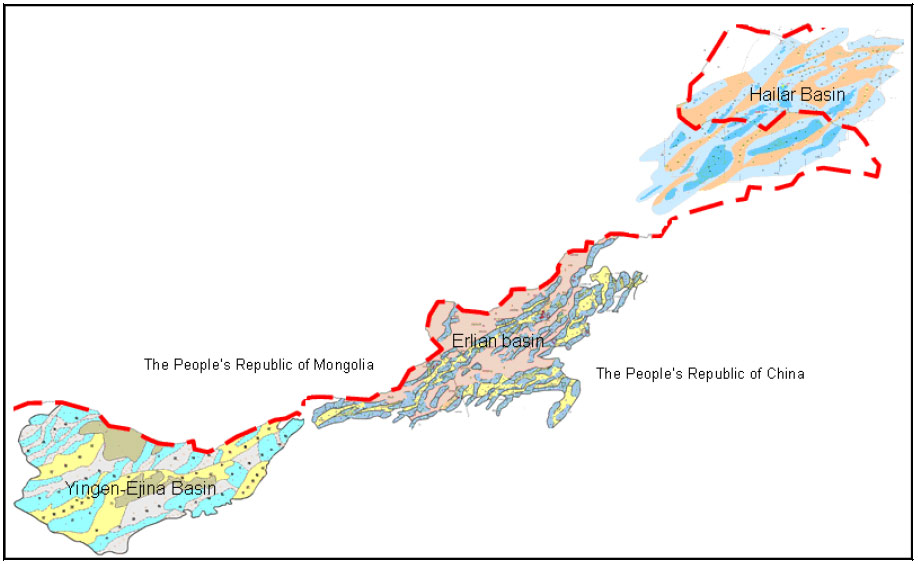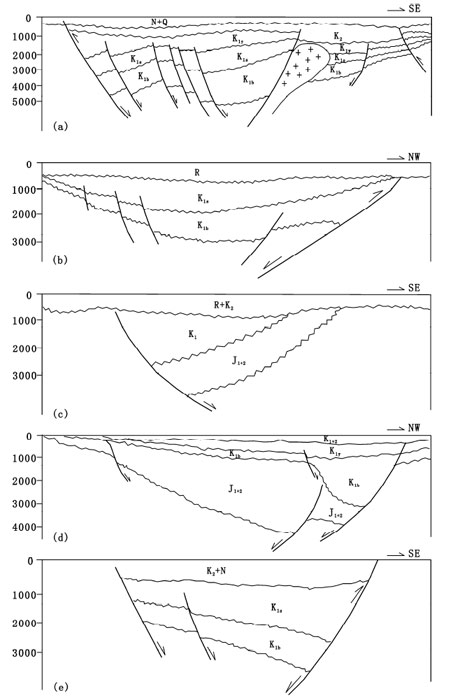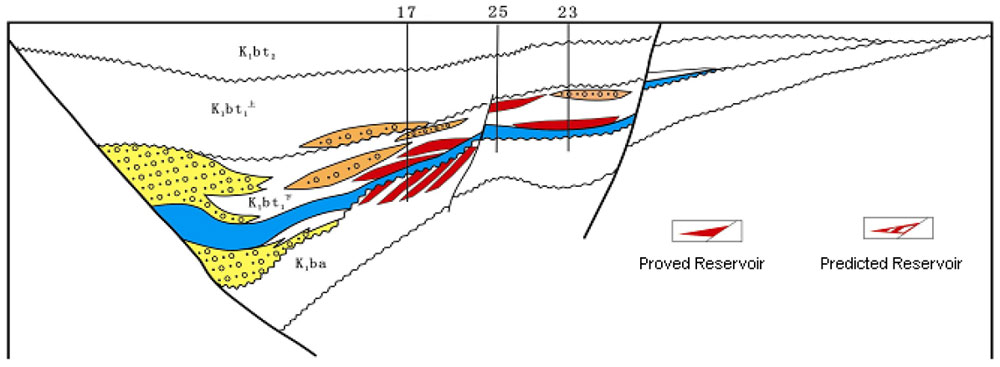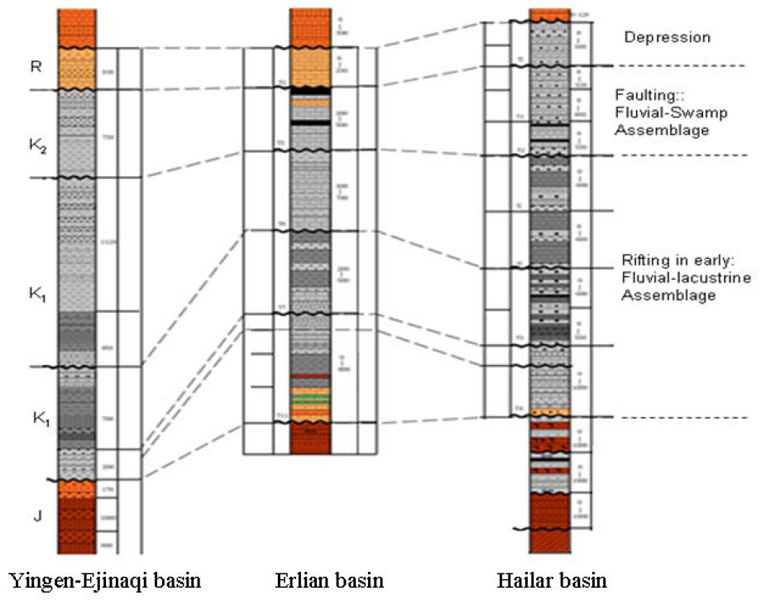Structural Features and Exploration Domains of Stratigraphic Reservoirs of Passive Rift Basin Group in Northern China
Chen, Qilin1; Wei, Pingsheng2; Yang, Zhanlong1; and Wang, Jiangong1
1Northwest Branch, Research Institute of Petroleum Exploration and Development, PetroChina, Lanzhou, Gansu Province, 730020, P.R.China ([email protected]).2Northwest Branch, Research Institute of Petroleum Exploration and Development, PetroChina, Lanzhou, Gansu Province, 730020, P.R.China
Abstract
The total area of Yingen-ejina basin, Eran basin and Hailar basin in northern China is more than 26.7×104km². This basin group is petroliferous basin of Cretaceous source rock and is characterized by passive rift basins. The common structure features of this rift basin group are developed from a nearly united basement of later Paleozoic, rift formed from Jurassic to Later Cretaceous, structures distributed mainly in direction of NE to NEE, Normal faults controlled the main bodies of sedimentation and Convex and faulted depressions developed alternatively. All the typical depressions of these rift basins commonly developed the structural slopes which resulted from the long period movement of basement structure and synsedimentary structures. These structural slopes mainly controlled the distribution of sandstone bodies and they are the favorable domains for the exploration of stratigraphic reservoirs. The gentle slopes, multi-level fault zone in steep slopes and structural flexures in various depressions of rift basins are the favorable zones for the exploration of lithologic reservoirs and the overlap zones in gentle slopes of fault depressions are the favorable zones for the exploration of stratigraphic reservoirs. Comprehensive analysis shows that the rift basin groups are the main exploration domain for lithologic to stratigraphic reservoirs exploration and proposed effective approach for these types reservoir exploration.
Introduction
The rift basin group in northern China refers to the Yingen-Ejina basin, Erlian Basin and Hailar Basin, which situated from the east of Beishan Mountain to the west of Daxinganling Mountain and mainly distributed long the border of Sino-Mongolian with a total area of 26.7 × 104km². The rift basin include 98 depressions and 49 uplifts and have found different reservoirs, which include structure (anticline, fault-anticline, fault-block), lithologic, stratigraphic overlap and volcanic cracks etc and these are a main new exploration domain in mainland of China [1-4]
The rift basin group in northern China is rich in oil and gas resources and in lower exploration degree. At present time, the petroleum exploration is mainly focus on structural traps and the lithologic to stratigraphic trap are in infancy. Study shows that these type of reservoirs need to be deeply understood and they will be the main type of reservoirs for exploration breakthrough and reserve replacement in future.
Based on analysis of regional structural feature, structural evolution of typical fault-depression, sedimentary evolution and accumulation feature of main depression, we proposed that the rift gentle slope and multi-stage fault slope break in passive rift basin are the main domains for lithologic to stratigraphic reservoirs exploration. For the further exploration in passive rift basin in north China, the lithologic to stratigraphic reservoirs must be near depo-center of depression. This study provides the basis for exploration of lithologic to stratigraphic reservoirs and will promote breakthrough in petroleum exploration.
Promotion of question
Basin group refers to a combination of multiple basins in similar regional tectonic setting which are similar in tectonic evolution background, structural feature and stress field characteristics (Yang Zhanlong et al, 1999).
There are different understanding about the genetic mechanism and basin type of Meso-Cenozoic basins in northern China. Based on comparative regional analysis, the author proposed that the basins of passive rift basin group in northern China are common in stratigraphy and structural evolution. They are formed within uniform geologic setting and similar and comparable in accumulation characteristics. They have good exploration prospects and the lithologic to stratigraphic reservoirs are the main exploration domains in future.
The rift basin group in northern China have similar tectonic background and uniform stress field. The basins experienced similar tectonic evolution (Yang Zhongxuan, et al, 1999) and much similar in geologic features. These rift lake basin groups formed from early Jurassic to early Cretaceous with the direction of NE-NEE and the normal faults controlled the distribution of sedimentation. The 98 depressions are trending in NE to NEE and the deep concave depressions are under control of normal fault. At present time, the basins are separate in plane and each depression is an independent unit of sedimentation or petroleum system. The basins of rift basin group are common in generation and comparable in structure, sedimentation and accumulation.
Comparable in lithologic assemblages and featured in single cycle of passive rift basins
(1) In vertical, the fluvial to lacustrine assemblages is formed in the early rift stage and fluvial to swamp assemblages in medium stage. The grain size in sedimentary cycle is changing from coarse-fine-coarse and the stratigrpahic correlation is good in horizontal (fig 1).
(2)The naming of formation groups are different between basins, but the strata are comparable in lithologic assemblage. There are coarse clastic of gray, sallow, grey-green conglomerate, pebbly sandstone and pink sandstone in the bottom of the lower Cretaceous. There are grey clay to shale interbedded with thin-bedded sandstone and pebbly sandstone in the central of the lower Cretaceous. There are gray shale interbedded with yellow to gray thin-bedded marl, siltstone, gray-green thin-bedded fine-grained sandstone, gray-green thick-bedded conglomerate and black oil shale. In the top of the lower Cretaceous, the lithology assemblages mainly are mafic volcanic rock interbedded with a small amount of gray, brown red mudstone, marl, sandstone and conglomerate. The upper Cretaceous is relatively homogeneous in lithology assemblage and stable in horizontal and vertical, the lithology assemblages mainly are brick red to brown red pebbly sandstone, muddy conglomerate, conglomerate and argillaceous siltstone.
(3) The hydrocarbon source rock is in good correlation. The fluvial to lacustrine assemblages formed in the early rift phase are the main source rock, which mainly situated in the central of the lower Cretaceous and the lithology mainly are dark shale within semi-deep to deep lake facies. In Yingen-ejinaqi basin, the source rocks mainly are semi-deep lacustrine mudstone within the second phase of Bayingebi formation. In Erlian basin, the source rocks mainly are semi-deep lacustrine mudstone within the first phase of Tenggeer formation. In Hailar Basin, the source rocks mainly are deep lacustrine mudstone within the first phase of Nantun formation. All of these hydrocarbon source rocks mainly deposited in the relative stable phase during the expansion stage of rifting and controlled by the depocenter, which shows the paleao-climate and environment is table and the source rock is widely distributed within the north rift domain.
The passive rift basin group is generated in a unified tectonic setting and a same mechanic stress
(1) Having a unified base background. The Yingen-Ejinaqi basin, Erlian basin and hailer basin are generated on the Tianshan-xingmeng belt and the basement is Hercynian folded belt or the block involved in this fold belt (Zhang Wenzhao, 1997; Fei Baosheng, 2002).
(2) This rift basin group is formed during the Yanshan tectonic movement and having the feature of passive rift basin (Fei Baosheng, 2002; Chen Qilin, 2006) which mainly trend in NE to NEE.
(3) The boundary faults controlled the formation of basins. The basin group is formed within the huge arc-type central Asia-Mongolian structural belt and developed many deep fault. These deep faults are partly re-survival within Mesozoic and induced the formation of multiple sub-basin-controlled faults. All of that resulted in the formation of many small basins (fig 2).
The depressions of basin group are in similar structure and having same mechanic cause
(1) The depressions formed in same period and trend. All the 96 depressions from Yingen-Ejinaqi basin in the west, Erlian basin to the Hailar basin in the east are trend in NE to NEE and formed in a same geological background. The beginning rifting time is from Jurassic to Cretaceous.
(2) The fault depression boundary is controlled by normal faults. All the boundary of depression is normal fault with large detachment and the controlled the depocenter of depression.
(3) The rift depressions are divided into single and double-off types. The formation of single-off type depressions is controlled by boundary faults and the depocenter is near the boundary fault. According to fault distribution, internal structure of depression, overlap relationship of stratigrphy, the single-off type depression is classified into single-fault-ladder type, single-fault-depression type and single-fault-overlap type (fig 3). The double-off type depression is controlled by two different faults with different detachment and the depocenter is near the main fault.
Accumulation feature and exploration domains
(1)Source rock in deep sag controls the distribution of reservoir. Different structure type of depression is various in accumulation condition, especially the structural reservoir is mainly controlled by the sub-unit sag within a depression, then is the gentle slope (fig 4).
(2) Slope break controls the accumulation of petroleum.
(3) Reservoir near the source rock and the unconformity are the main accumulation zones of hydrocarbon. The faults which connected with the source rock and unconformity are the main conduit system of hydrocarbon (fig 5).
References:
1 Fei Baosheng, Petroleum Exploration of Rift Basin Group in Area of Northeast Asia, Shown by the Erlian Basin, Petroleum Geology & Oilfield Development in Daqing 2002, 21(3).
2 Zhang Wenzhao, The law of oil controlled by subsags and prospect of petroleum exploration in Hailar basin, ACTA PETROLEI SINICA, 1997, 18(4).
3 Chen Shoutian, Oil-gas bearing system of Hailar basin, Journal of Changchun University of Science and Technology, 2002, 32(2).
4 Yang Zhongxuan, Petroleum exploration progress and basic geologic conditions, Zhao Zhengzhang, Oil & gas exploration of Oil company, Petroleum industry press, 1999.
5 Yang Zhanlong, Concept and implication of basin group, Northwest petroleum exploration, 1999, 11(3).
6 Zhang Jiguang, Formation of Unconformity and Its Oil/Gas Geological Significance in Hailar Basin, Petroleum Geology & Oilfield Development in Daqing, 2002, 21(5).
7 Yi Shiwei, The depression structure and accumulation model in Erlian basin, Petroleum exploration and development, 1998, 25(2).
8 Yue Fusheng, Study on Hydrocarbon Pool Formation and Prospect Targets of Reconstructed Basin-An example of Yingen-Ejinaqi basin, Xinjiang Petroleum Geology, 2002, 23(6).
9 Lin Changsong, Structural slope-break zone: Key concept for stratigraphic sequence analysis and petroleum forecasting in fault subsidence basins, Earth Science - China University of Geosciences, 2000, 25(3).
10 Chen Qilin, Tectonic evolution and petroleum prospecting in Yingen-Ejina basin, Petroleum Geology & Experiment, 2006.
11 Chen Qilin, Depression structural-style types and petroleum accumulation, rift basin group of Yingen-Ejina, Natural Gas Geosciences, 2005,16(5):559-563.
 Figure 2. Distribution of basins and depression within passive rift basin group in northern China.
Figure 2. Distribution of basins and depression within passive rift basin group in northern China.
 Figure 3. Depression types within passive rift basin group in northern China.
Figure 3. Depression types within passive rift basin group in northern China.
 Figure 4. Source rock in deep sag controls the distribution of reservoir.
Figure 4. Source rock in deep sag controls the distribution of reservoir.
 Figure 5. Relationship of petroleum accumulation and faults and unconformity.
Figure 5. Relationship of petroleum accumulation and faults and unconformity.
AAPG Search and Discovery Article #90135©2011 AAPG International Conference and Exhibition, Milan, Italy, 23-26 October 2011.

 Fgiure 1. Lithology assemblage correlation of the three basins of passive rift basin group in northern China.
Fgiure 1. Lithology assemblage correlation of the three basins of passive rift basin group in northern China.